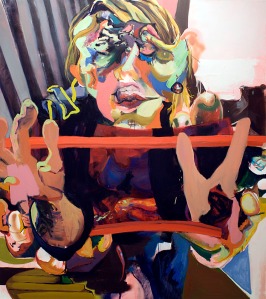My favorite American painter
TRUE/SLANT - 16 DECEMBER 2009
Jeremy Willis's paintings are a meditation on longing. And much of his work -- a collection of oil-on-canvas paintings -- actually depicts figures who reach out, who provoke the viewer. As a result, his subjects feel as if they long to be more than the sum of their parts -- quite actually more than the body they inhabit. And like each of us, the figures Willis paints seem to be locked in a dim but growing awareness that having such hope is as foolish and endless an endeavor as it must and always will be.
But where is human history without longing? And where are any of us without someone to tell us what we want? Popular culture often imagines the best we can be, just as it creates new and limiting borders to the notion of what is civilized, to what is and should be desired. Willis's paintings lull viewers into thinking that such idealization -- in film, TV, magazines, and others -- might even be something like a hopeful projection. But the paintings ultimately seem to flip that idea, arguing instead that such projections rarely stray from acts of vanity and/or cruelty. Nowhere is the tension between these two poles (adoration, hatred) seen more astonishingly and horrifyingly than in Willis's depictions (of depictions) of sexualized men and women -- sex being what humans are programmed to desire most, and what we connive most bizarrely both to get and to prevent.

- I Love You Too (2008)
Some of Willis's figures -- male and female -- are painted to embrace the viewer. Others are painted to assault the viewer with a kind of visual violence of cajoling, demanding, and taunting. Still others ask for compassion, appearing in human situations of deep compromise -- pain, violation, hunger -- that leave the viewer both disturbed and, perhaps, aroused.
Willis's paintings come from both a critical perspective and also one of genuine and joyous hunger. As such, and because of the difficult male/female terrain he portrays, Willis ends up implicating himself in the great and grotesque game of indulging acts of potential irresponsibility (or even criminality.) The results of his effort -- in paint, leveled out and naked to the viewer's eye -- are, it seems, as challenging and personal for the painter as they might be for you and I.
All of us aspire to that which we cannot have. By grappling with both the lurid absurdity and the deadening terror of this predicament, Willis's paintings place themselves at the very heart of our most important conversations -- the ones about love, about death, and about what matters in life. If Willis is doing his job right, perhaps for you too the paintings will steer you even a few degrees towards a better understanding -- or, indeed, towards a less painful personal compromise.
 -- Criticism
-- Criticism